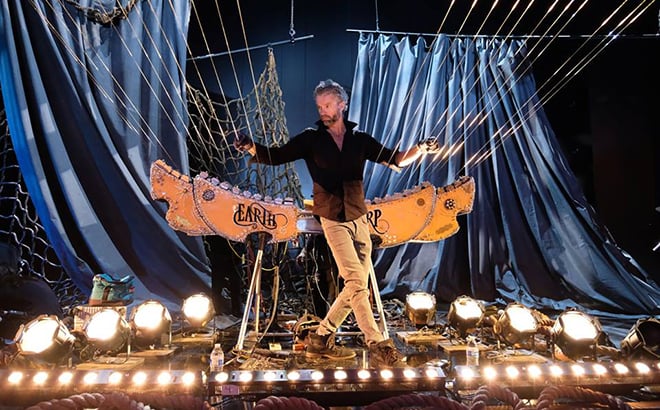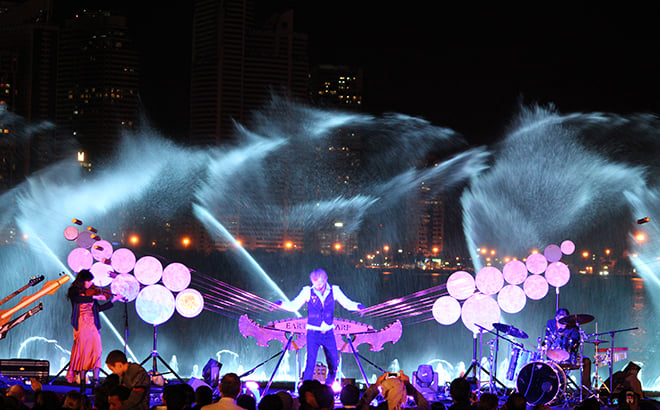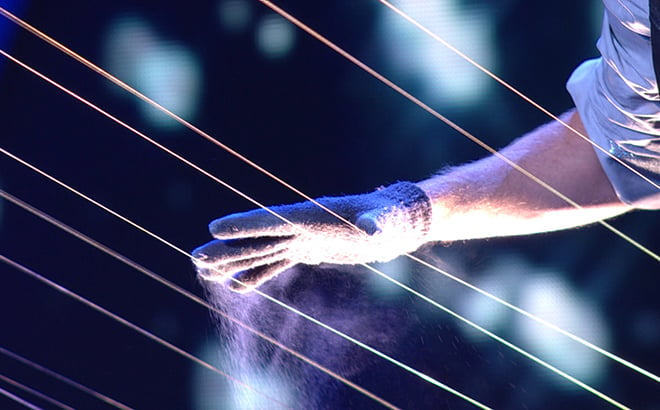Summer Nights Live: William Close & The Earth Harp Collective

William Close & The Earth Harp Collective - Performing July 22 – 28
Not only is the largest stringed instrument on the planet interesting to look at, it's also a one-of-a-kind acoustic experience. America's Got Talent finalist William Close & The Earth Harp Collective is at Busch Gardens Williamsburg for one week only for Summer Nights Live—don't miss your chance to see the Earth Harp in action at the Globe Theatre! Until then, read on to learn more about the mind behind one of the most innovative instruments you'll ever hear.

Busch Gardens Williamsburg: Thank you for taking the time to talk with us! How did you get into music? And what advice would you give to aspiring musical artists?
William Close: I actually came to music from design. I studied design, sculpture, and architecture, and those interests formed my passion for music. And I grew up on sail boats and I was always interested in that element of rigging, and so in a lot of ways I would say that sailing inspired my love of music as well. I always loved combining different mediums, and so I started combining sculpture and music and architecture to create new instruments like the Earth Harp. And if I were to offer advice to another artist or musician, I would say that it’s good to allow different interests inspire your main interests. If you’re a musician, maybe you want to be inspired by painting or film, or vice versa.
BGW: Before inventing the Earth Harp, what was your experience with the combination of art installation and music?
WC: I always loved the quote, “Architecture is frozen music.” And so that whole idea of seeing the architecture of a building as music really sparked my interest in terms of what it might be to create music on a large scale, installation style. That quote really speaks to noticing the rhythmic patterns in architecture and made me think of the way sound travels through different spaces. For example, how it resonates in a big atrium space, or how a stairwell or a hallway produces an echo. And then I’d go play music in those spaces and I always found the differences interesting.
BGW: Can you say a bit about the Earth Harp? How does it work? What is the process for installing it in a venue?
WC: The Earth Harp gets its title from the first time I set it up. It was in a canyon, and I ran the strings clear across from one side to the other, effectively turning the canyon into a giant harp. Since then I’ve attached it in many different spaces including mountain peaks, across fields, in beautiful theaters and concert halls, and to the tops of skyscrapers. The idea came from questioning what it would be like to turn the landscape into the instrument and finding that synthesis between design, architecture, sculpture, and music. It all started with running strings across my loft in Chicago when I was in art school to try to figure out if you could actually make music that way. When I figured out that you could, that’s when I started thinking about it on a larger scale, with strings from 20 to 400 feet long. To play the Earth Harp, you put on cotton gloves that have been coated in violin resin and you run your hands along the strings, sort of pulling at the strings, to produce a beautiful tone called a compression wave. It’s the same principle as when you run your finger on the edge of a wine glass. When we install it at Busch Gardens, the resonator and the bridge of the instrument will attach to the stage, and the strings will go out over the audience and attach to the architecture of the theater. We’ll essentially be turning the theater into the instrument, and the audience will be watching the show from inside it.
BGW: What has been one of your favorite venues to perform in? What made it such a special experience?
WC: I really loved stringing the Earth Harp to the top of skyscraper in Singapore. It was an interesting rigging process because the strings were over 1,000 feet long and we had to lower them from the top of the building one by one and walk them across a complex plaza area. The first string took about two hours to set up, but by the end we had gotten that time down to fifteen minutes. And that was also the show where we received the world record for longest playable instrument.
BGW: Do differences in the architecture of different venues impact the sound if the instrument?
WC: Different architecture definitely impacts the resonance of the instrument. If I have the Earth Harp set up in a big, beautiful glass atrium or some of the bigger museum atriums the sound is more resonate and it reverberates, whereas if I’m in a canyon - sometimes I’ll get an echo from it. If I’m in a theater, it’s really nice and focused and quiet so you really hear the depth and beauty of the instrument. In a theater like the one at Busch Gardens, the audience will be sitting right under the strings, so they’ll really be able to hear the sound as it’s above and around them.



